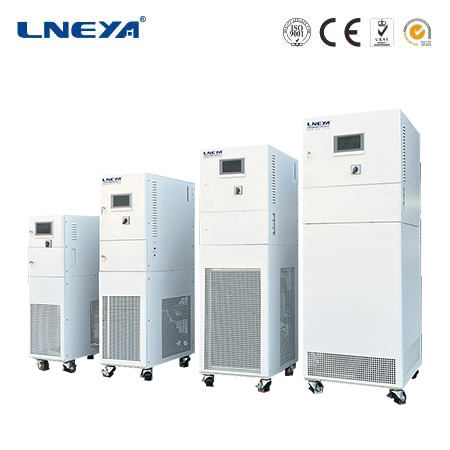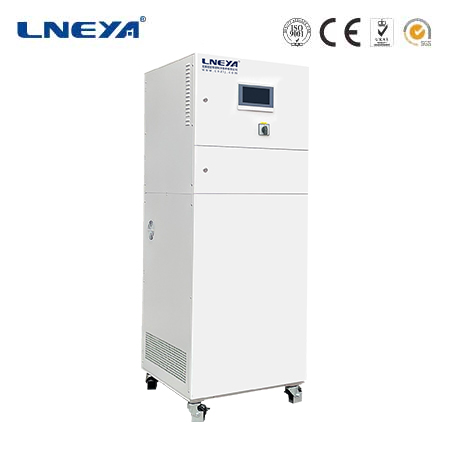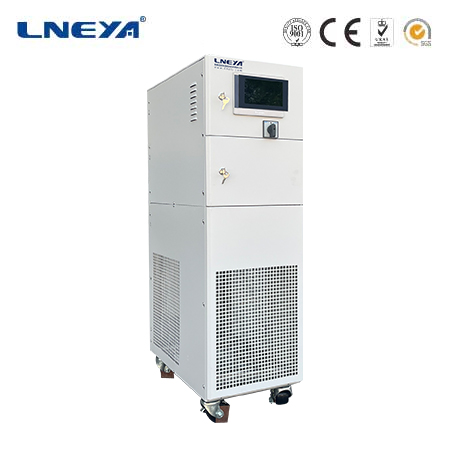recirculating heater chiller
Introduction to Recirculating Heater Chillers
Recirculating heater chillers are sophisticated temperature – control systems that play a vital role in maintaining a consistent temperature for a circulating fluid. They are designed to provide both heating and cooling capabilities, making them highly versatile. These units are widely used in a variety of settings, from research laboratories to industrial manufacturing plants, where precise temperature regulation is essential for the proper functioning of processes and equipment. By continuously recirculating the fluid, they ensure uniform temperature distribution and efficient heat transfer.

Working Principles
Heating Principles
Electric Resistance Heating
Operation: In many recirculating heater chillers, electric resistance heating is a common method. Electric resistance heaters consist of elements made of materials with high electrical resistance, such as nichrome. When an electric current passes through these elements, heat is generated according to Joule’s law (Q = I²Rt, where Q is the heat generated, I is the current, R is the resistance, and t is the time). For example, in a small – scale benchtop recirculating heater chiller used in a laboratory, the electric resistance heating elements are submerged in the fluid to be heated. As the current flows through the elements, they heat up, and the heat is transferred to the fluid. A pump then circulates the heated fluid through the system, maintaining a uniform temperature.
Advantages and Disadvantages:
Advantages: Electric resistance heating is relatively simple in design and easy to control. It can quickly generate heat, providing rapid temperature increases. It also offers precise temperature control as the amount of heat generated can be adjusted by controlling the electric current.
Disadvantages: It can be energy – intensive, especially for large – scale heating requirements. The efficiency of electric resistance heating may be lower compared to some other heating methods, and there is a risk of overheating if the temperature control system malfunctions.
Heat – Exchanger – Based Heating
Operation: In some industrial – grade recirculating heater chillers, heat – exchanger – based heating is employed. A heat exchanger is used to transfer heat from a hot fluid (such as steam or hot water from a boiler) to the fluid being recirculated. For instance, in a manufacturing plant, a shell – and – tube heat exchanger may be used. The hot fluid flows through the shell side of the heat exchanger, while the recirculating fluid passes through the tubes. Heat is transferred from the hot fluid to the recirculating fluid, raising its temperature. This method is often used when there is an available heat source, such as waste heat from other industrial processes.
Advantages and Disadvantages:
Advantages: It can be more energy – efficient when using a waste heat source, as it recycles otherwise – wasted energy. Heat – exchanger – based heating can also handle large – volume fluid heating requirements more effectively.
Disadvantages: The installation and maintenance of heat – exchanger systems can be more complex. There is a need for a reliable hot – fluid source, and any fluctuations in the hot – fluid temperature or flow rate can affect the heating performance of the recirculating heater chiller.

Cooling Principles
Vapor – Compression Cooling
Operation: Vapor – compression cooling is a widely used mechanism in recirculating heater chillers. The process starts with a compressor. The compressor takes in low – pressure, low – temperature refrigerant vapor. As it compresses the vapor, the pressure and temperature of the refrigerant increase significantly. The hot, high – pressure refrigerant vapor then enters the condenser. In a water – cooled condenser, which is common in many applications, the refrigerant releases heat to a secondary water loop. As the refrigerant loses heat, it condenses into a high – pressure liquid. The high – pressure liquid refrigerant then passes through an expansion valve, which reduces its pressure and causes it to cool down. The cold, low – pressure refrigerant enters the evaporator, where it comes into contact with the recirculating fluid. The refrigerant absorbs heat from the fluid, cooling it down. As the refrigerant absorbs heat, it vaporizes and returns to the compressor to start the cycle again. In an industrial recirculating heater chiller used for cooling process fluids, this vapor – compression cycle ensures efficient heat removal.
Advantages and Disadvantages:
Advantages: Vapor – compression cooling offers high cooling capacity and is highly efficient for large – scale cooling requirements. It is a well – established technology with a wide range of refrigerant options available.
Disadvantages: The system requires a compressor, which consumes a significant amount of energy. Some refrigerants used in the past, such as chlorofluorocarbons (CFCs) and hydrochlorofluorocarbons (HCFCs), have been found to be harmful to the ozone layer, although more environmentally – friendly alternatives are now in use.
Thermoelectric Cooling
Operation: Thermoelectric cooling in recirculating heater chillers is based on the Peltier effect. When an electric current is passed through a junction of two different semiconductor materials, heat is either absorbed or released at the junction. In a thermoelectric cooling setup, multiple thermoelectric modules are often used. One side of the module acts as a cold junction, which is in contact with the recirculating fluid to be cooled, while the other side acts as a hot junction. As the electric current flows through the modules, heat is absorbed from the fluid on the cold side, cooling the fluid. The heat absorbed is then transferred to the hot side of the modules. A heat sink and a fan are typically used on the hot side to dissipate the heat. This setup allows for precise temperature control, especially in applications where a compact and quiet cooling solution is required, such as in some laboratory – grade recirculating heater chillers.
Advantages and Disadvantages:
Advantages: Thermoelectric cooling is compact and has no moving parts (except for the fan used for heat dissipation), which reduces the risk of mechanical failure. It offers precise temperature control and can be easily adjusted by changing the electric current.
Disadvantages: It has a relatively lower cooling capacity compared to vapor – compression cooling, making it more suitable for small – scale applications. Thermoelectric cooling can also be less energy – efficient for large – scale cooling requirements.
Types of Recirculating Heater Chillers
Benchtop Recirculating Heater Chillers
Design and Features
Benchtop recirculating heater chillers are compact units designed to be placed on a laboratory bench or a small – scale workstation. They are typically used for small – volume fluid temperature control. These units often have a built – in reservoir to hold the fluid to be circulated. They come with user – friendly controls, allowing operators to set the desired temperature precisely. Many benchtop models have digital displays that show the current fluid temperature, set temperature, and other operational parameters. They usually have a relatively small cooling and heating capacity, with cooling capacities ranging from a few hundred watts to a few kilowatts and heating capacities in a similar range.
Applications
In laboratories, benchtop recirculating heater chillers are used for a variety of applications. They can be used to cool or heat small reaction vessels in chemical synthesis experiments. For example, in a pharmaceutical research laboratory, they can be used to maintain the optimal temperature for enzymatic reactions. They are also useful for cooling analytical instruments such as high – performance liquid chromatography (HPLC) systems, ensuring accurate analysis by controlling the temperature of the mobile phase or the detector.
Industrial – Grade Recirculating Heater Chillers
Configuration and Capacity

Industrial – grade recirculating heater chillers are much larger and more powerful. They are designed to handle large – scale industrial processes. These units typically consist of a main chiller/heater unit, a circulation pump, and a complex control system. The main unit houses the heating and cooling components, such as electric resistance heaters, compressors (for vapor – compression cooling), or thermoelectric modules. The circulation pump is responsible for moving the fluid through the system at a high flow rate. Industrial – grade units have a much higher cooling and heating capacity, with cooling capacities often ranging from tens of kilowatts to hundreds of kilowatts and heating capacities to match the cooling requirements of large – scale industrial processes.
Applications
In manufacturing industries, industrial – grade recirculating heater chillers are used in processes such as plastic injection molding. The molds in plastic injection molding need to be precisely heated and cooled to ensure the quality of the plastic products. In the food and beverage industry, they are used in processes like brewing, where the temperature of the fermentation tanks needs to be carefully controlled. In data centers, industrial – grade recirculating heater chillers can be used to cool the servers and other electronic equipment, and in some cases, also to heat the environment during cold periods to maintain optimal operating conditions.
Applications of Recirculating Heater Chillers
Pharmaceutical Industry
Drug Synthesis
In pharmaceutical drug synthesis, recirculating heater chillers are used to control the temperature of reaction vessels. Many drug – synthesis reactions are highly temperature – sensitive. For example, in the synthesis of complex organic molecules, the reaction rate and the formation of by – products can be significantly affected by temperature. Recirculating heater chillers ensure that the reaction mixture is maintained at the optimal temperature, which is crucial for obtaining a high yield of the desired drug compound and minimizing the formation of impurities.
Bioreactor Temperature Control
In bioreactors used for culturing cells or microorganisms in the pharmaceutical industry, precise temperature control is essential. Recirculating heater chillers are used to maintain the temperature within a narrow range suitable for cell growth and metabolism. The temperature affects the activity of enzymes and the overall physiological processes of the cells. By accurately controlling the temperature, the pharmaceutical industry can ensure consistent and high – quality production of biologics such as vaccines and monoclonal antibodies.
Manufacturing Industry
Plastic Processing
In plastic processing, such as plastic injection molding and extrusion, recirculating heater chillers play a vital role. In plastic injection molding, the molds need to be heated to a specific temperature to melt the plastic pellets and then cooled rapidly to solidify the plastic into the desired shape. Recirculating heater chillers provide the necessary heating and cooling cycles, ensuring dimensional accuracy and high – quality finish of the plastic products. In plastic extrusion, they are used to control the temperature of the extruder barrel and the cooling water for the extruded plastic profiles, which affects the physical properties of the plastic products.
Metalworking
In metalworking processes like metal casting and machining, recirculating heater chillers are used for temperature control. In metal casting, the molds may need to be pre – heated to a certain temperature before pouring the molten metal. After casting, the castings may need to be cooled at a controlled rate to achieve the desired microstructure and mechanical properties. In machining, recirculating heater chillers can be used to cool the cutting tools and the workpiece, reducing tool wear and improving the surface finish of the machined parts.
Laboratory Applications
Analytical Instrument Cooling and Heating
As mentioned earlier, recirculating heater chillers are used to cool and heat analytical instruments in laboratories. In addition to HPLC systems, they are also used for nuclear magnetic resonance (NMR) spectrometers. The magnet in an NMR spectrometer generates a large amount of heat, and maintaining a constant temperature is crucial for the stability of the magnetic field and accurate spectral analysis. Recirculating heater chillers help in removing the heat generated by the magnet and, in some cases, also in heating the instrument during start – up or calibration procedures to ensure optimal performance.
Experimental Research
In various experimental research projects, recirculating heater chillers are used to control the temperature of experimental setups. For example, in materials science research, when studying the phase transitions of materials, precise temperature control is required. Recirculating heater chillers can provide the necessary heating and cooling steps to induce and monitor the phase transitions accurately.
Maintenance of Recirculating Heater Chillers
Fluid Quality Checks
Scale and Corrosion Prevention
The quality of the fluid circulated in a recirculating heater chiller is of utmost importance. Water – based fluids, especially those with high mineral content, can cause scale formation on the heat exchanger surfaces (both for heating and cooling). Scale acts as an insulator, reducing the efficiency of heat transfer. To prevent scale formation, water treatment methods such as water softening can be employed. Water softeners remove calcium and magnesium ions from the water, which are the main components responsible for scale formation. Additionally, anti – scale agents can be added to the fluid.
Corrosion is another concern. If the fluid contains dissolved oxygen or other corrosive substances, it can corrode the metal components of the recirculating heater chiller, such as the heat exchanger tubes, circulation pipes, and pump components. Corrosion inhibitors are added to the fluid to protect the metal surfaces. Regular fluid testing should be carried out to monitor the levels of dissolved oxygen, pH, and other parameters that can affect scale formation and corrosion.
Fluid Level Monitoring
Monitoring the fluid level in the recirculating heater chiller is essential. A low fluid level can lead to reduced cooling or heating performance and may even cause damage to the equipment. Most recirculating heater chillers are equipped with fluid – level sensors that can alert operators when the fluid level is low. Regular visual inspections of the fluid – level gauge (if available) should also be carried out. If the fluid level is low, the appropriate fluid should be added, taking care to use the correct type of fluid recommended by the manufacturer.
Component Inspections
Heating Element Inspection
For recirculating heater chillers with electric resistance heating elements, regular inspection of the heating elements is necessary. Check for any signs of damage, such as cracks or burn marks. The electrical connections to the heating elements should also be inspected to ensure they are secure and free from corrosion. If a heating element is damaged, it may need to be replaced to ensure proper heating performance. In heat – exchanger – based heating systems, the heat exchanger should be inspected for leaks, fouling, and proper heat – transfer efficiency.
Cooling Component Inspection
In vapor – compression – based recirculating heater chillers, the compressor is a critical component. Regular inspections should be carried out to check for signs of wear, such as unusual noises or vibrations. The oil level in the compressor should be monitored and changed according to the manufacturer’s recommendations. The condenser and evaporator coils should be inspected for dirt, debris, and signs of corrosion. In thermoelectric – cooled recirculating heater chillers, the thermoelectric modules should be inspected for any signs of damage, such as cracks or loose connections. The heat sink and fan used for heat dissipation should also be checked for proper operation.
Pump and Valve Inspections
The circulation pump in a recirculating heater chiller is responsible for moving the fluid through the system. Regular inspections of the pump should be carried out to check for proper flow rate, leaks, and mechanical wear. The impeller of the pump should be inspected for any signs of damage or clogging. Valves in the system, such as control valves and check valves, should also be inspected to ensure they are operating correctly. Malfunctioning valves can affect the flow of the fluid and the overall performance of the recirculating heater chiller.
Calibration
Temperature Sensor Calibration
The temperature sensors in a recirculating heater chiller are crucial for accurate temperature control. Over time, the temperature sensors may drift, leading to inaccurate temperature readings. Calibration of the temperature sensors is necessary to ensure that the set temperature and the actual fluid temperature match. Calibration involves comparing the sensor readings with a known – accurate reference thermometer and adjusting the sensor settings if necessary. This calibration should be carried out regularly, and the frequency may depend on the manufacturer’s recommendations and the criticality of the temperature control in the application.
Control System Calibration
The control system of a recirculating heater chiller, which regulates the heating and cooling operations based on the temperature sensor readings, also needs to be calibrated. The control system may need to be adjusted to ensure that it responds correctly to changes in temperature. For example, the proportional – integral – derivative (PID) controller settings may need to be optimized to achieve the desired temperature stability. Calibration of the control system helps in maintaining the accuracy and reliability of the recirculating heater chiller’s temperature – control capabilities.
Choosing the Right Recirculating Heater Chiller
Temperature Range Requirements
Determining the Required Temperature Range
The first step in choosing a recirculating heater chiller is to determine the required temperature range for your application. Different processes and equipment have different temperature requirements. For example, in a pharmaceutical drug – synthesis reaction, the temperature may need to be controlled within a very narrow range, such as ±0.1°C. In a plastic injection – molding process, the temperature range for heating and cooling the molds may be much wider. Understanding the specific temperature range requirements of your application is crucial as it will help in selecting a recirculating heater chiller that can meet these requirements.
Related recommendations
industrial chiller machine
183Types of Industrial Chiller MachinesIndustrial chillers are classified based on their cooling method, compressor type, and intended application, each offering unique advantages for specific indus...
View detailscooling system machine
452Understanding the Total Cost of Ownership for Cooling System Machines Industrial cooling systems are essential for maintaining optimal operating temperatures in various manufacturing and proces...
View detailschiller for distillation
683Chiller Systems for Distillation: A Key Component in Alcohol Production In the production of distilled spirits, temperature control is paramount. Chiller systems play a vital role in ensuring t...
View detailsheater manufacturing company
445Heater Manufacturing Company: A Complete Guide Introduction Heater manufacturing companies play a crucial role in providing efficient and reliable heating solutions for various applications....
View details
 LNEYA Thermal Test Chillers
LNEYA Thermal Test Chillers





HelloPlease log in